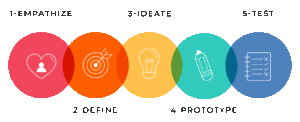Design thinking has been shown to have positive impacts on both creativity and business performance. According to a study by the Design Management Institute, design-led companies outperformed the S&P 500 by 228% over a 10-year period. Additionally, a survey of 758 executives found that companies that used design thinking reported increased innovation, improved user experience, and higher customer satisfaction. These findings suggest that design thinking can not only lead to more creative solutions but also better business outcomes.
What is Design Thinking?
Design thinking is a problem-solving approach that involves understanding people’s needs and empathizing with their challenges to create solutions that meet their needs. It is a human-centered process that places people at the center of the design process, focusing on their needs, desires, and aspirations. The design thinking process has become a popular methodology for solving complex problems in various industries, including technology, healthcare, education, and business.
Design Thinking Process
The design thinking process comprises five stages: empathize, define, ideate, prototype, and test. In this blog, we will explore each of these stages in detail, discuss their importance, and provide practical tips for applying them.
Empathize
The empathize stage of the design thinking process involves understanding the needs, challenges, and aspirations of the users. To do this, designers must observe and listen to users without bias or judgment. The goal of empathy is to gain a deep understanding of the user’s perspective and experience. During this stage, designers use tools such as user interviews, user surveys, observation, and immersion to gather data and insights.

Practical tips for applying empathy:
- Conduct user interviews to gain insight into their needs and experiences: Conducting user interviews is an effective way to gather information about user needs, challenges, and aspirations. By asking open-ended questions and listening actively, designers can gain valuable insights into user behaviour and motivations.
- Observe users in their natural environment to understand their behavior and context: Observing users in their natural environment can provide designers with a deeper understanding of user behaviour and context. This can help designers identify pain points, challenges, and opportunities that may not be immediately apparent.
- Use tools like personas, empathy maps, and customer journey maps to visualize user insights and create a shared understanding among team members: Personas, empathy maps, and customer journey maps are tools that can help designers visualize user insights and create a shared understanding among team members. These tools can also help designers identify patterns, themes, and opportunities that can inform the design process.
Define
The define stage of the design thinking process involves synthesizing the information gathered during the empathize stage to create a clear problem statement. Defining the problem helps designers focus on the most significant challenges and opportunities. During this stage, designers use tools such as problem framing, problem definition, and design criteria to create a problem statement that inspires creativity and innovation.

Practical tips for defining the problem:
- Use insights gathered during empathy to create a user persona and problem statement: The insights gathered during the empathy stage can be used to create a user persona and problem statement. The user persona represents the user’s needs, challenges, and aspirations, while the problem statement defines the problem to be solved.
- Frame the problem in a way that inspires creativity and innovation: Framing the problem in a way that inspires creativity and innovation can help designers generate more innovative solutions. This can be done by reframing the problem from different perspectives, using metaphors or analogies, or asking provocative questions.
- Ensure that the problem statement is specific, actionable, and measurable: The problem statement should be specific, actionable, and measurable. This will help designers focus on the most significant challenges and opportunities and ensure that the solution can be evaluated and tested.
Ideate
The ideate stage of the design thinking process involves generating a range of creative ideas and solutions to address the problem defined in the previous stage. Ideation is a collaborative and iterative process that involves brainstorming, sketching, and sharing ideas. During this stage, designers use tools such as brainstorming, mind mapping, SCAMPER, and reverse brainstorming to stimulate creativity and generate innovative solutions.

- Encourage wild ideas and brainstorming without judgment: Encouraging wild ideas and brainstorming without judgment can help designers generate more innovative solutions. By creating a safe and supportive environment, designers can help team members feel comfortable sharing their ideas, no matter how unconventional.
- Use ideation techniques such as mind mapping, SCAMPER, and reverse brainstorming to stimulate creativity: Ideation techniques such as mind mapping, SCAMPER, and reverse brainstorming can help designers stimulate creativity and generate more innovative solutions. These techniques can help designers break free from conventional thinking and explore new ideas and perspectives.
- Combine and refine ideas to generate innovative solutions: Combining and refining ideas can help designers
generate innovative solutions. During ideation, designers should aim to generate as many ideas as possible, and then combine and refine them to create a set of potential solutions. This can be done by looking for common themes, identifying strengths and weaknesses, and refining ideas based on feedback and testing.
Prototype
The prototype stage of the design thinking process involves creating tangible representations of the potential solutions generated during the ideation stage. Prototyping is a low-cost and low-risk way to test and refine ideas. During this stage, designers use tools such as sketches, wireframes, and mockups to create prototypes that can be tested and evaluated.

Practical tips for prototyping:
- Use low-fidelity prototypes to test and refine ideas quickly: Low-fidelity prototypes such as sketches, wireframes, and paper prototypes can be created quickly and allow designers to test and refine ideas without investing a lot of time and resources.
- Create multiple prototypes to explore different solutions: Creating multiple prototypes can help designers explore different solutions and identify the most promising one. By creating several prototypes, designers can test and evaluate different features, functions, and designs and identify areas for improvement.
- Test prototypes with users to gather feedback and insights: Testing prototypes with users can provide designers with valuable feedback and insights. By observing how users interact with the prototype, designers can identify areas for improvement and make informed design decisions.
Test
The test stage of the design thinking process involves testing the prototype with users to gather feedback and insights. Testing allows designers to evaluate the effectiveness of the solution and identify areas for improvement. During this stage, designers use tools such as user testing, A/B testing, and usability testing to evaluate the prototype and gather feedback.

Practical tips for testing:
- Test the prototype with users to gather feedback and insights: Testing the prototype with users is a critical step in the design thinking process. By observing how users interact with the prototype, designers can identify usability issues, pain points, and opportunities for improvement.
- Use A/B testing to compare the effectiveness of different solutions: A/B testing can be used to compare the effectiveness of different solutions. By testing two versions of the prototype with different features or designs, designers can identify the most effective solution.
- Use feedback from testing to refine the solution and iterate: Using feedback from testing to refine the solution and iterate is a critical step in the design thinking process. By incorporating feedback into the design, designers can improve the usability, functionality, and overall effectiveness of the solution.
Conclusion
In conclusion, the design thinking process is a human-centered, iterative approach to problem-solving. By focusing on empathy, defining the problem, ideating, prototyping, and testing, designers can create innovative solutions that meet the needs and aspirations of the users. Applying practical tips such as conducting user interviews, using ideation techniques, and testing prototypes with users can help designers create more effective and innovative solutions.
This brings us to the end of this blog on Design Thinking Process. Hope I was able to clearly explain what is UI/UX design and why you should use it.
If you want to get trained in UI UX Design Training and wish to develop interesting UIs on your own, then check out the Ui/UX design offered by Edureka, Our UI/UX design course, curated by industry experts that will help you to master all its concepts.
Got a question for us? Please mention it in the comments section and we will get back to you.


























